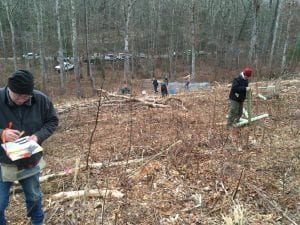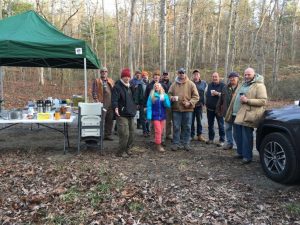We all know the story by now: a little more than 100 years ago, American chestnut (Castanea dentata) was rapidly removed as an overstory tree throughout the eastern United Sates by the fungal pathogen Cryphonectria parasitica, which causes chestnut blight. Now, The American Chestnut Foundation (TACF) is committed to restoring American chestnut through the hybridization of American chestnut with the highly blight resistant Chinese chestnut (Castanea mollissima), successively backcrossing the progeny with pure American chestnuts, and then intercrossing to fix resistance in our potentially blight-resistant (PBR) American chestnut.

Prior to planting, TACF volunteers help map and flag the site.
However, our breeding work has not gone without setbacks and/or questions regarding future restoration plans. Deer browse is a perennial problem with chestnut growers, and this problem is significant in forest settings, where deer browse is greater and deer exclusion can be limited by topographical constraints. Some deer exclusion strategies in forest sites include deer cages and tall tree tubes. We decided to test both methods against no protection (as a control) in a replicated study in a recent cutover in the George Washington National Forest.
December, 2016, approximately twenty TACF volunteers and US Forest Service crewmembers met to put 600 PBR chestnuts to the test. We established a completely randomized planting involving 200 seedlings protected with deer cages, 200 protected with tall tree tubes, and 200 unprotected. This study will provide an initial set of data regarding the survival, growth and deer browse of American chestnut within a recently harvested site. We will also observe long-term blight resistance and American-type competitiveness. This was all made possible by a generous grant from the National Forest Foundation’s Matching Awards Program.
Expected Results:
As progress continues through the TACF breeding program, American chestnut is poised for future reintroduction throughout its former range. We will expedite the restoration of this species by examining silviculture strategies that lead to successful establishment and long-term survival and growth rates. The expected results of this research will be to identify deer exclusion strategies that limit deer browse and lead to successful establishment of self-sustaining chestnut populations. With the ultimate goal being the development of American chestnut trees that are blight resistant, root rot resistant and American chestnuts that can grow and reproduce naturally thereby setting the stage for true species restoration throughout the eastern United States.

Volunteers take a break for some hot catered lunch!

Some seedlings get deer cages, some get tall tree tubes, and some are left unprotected.

Some volunteers collect data, while others plant trees and install deer exclusion.
